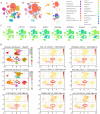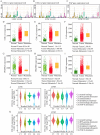Refining the optimal CAF cluster marker for predicting TME-dependent survival expectancy and treatment benefits in NSCLC patients
- PMID: 39034310
- PMCID: PMC11271481
- DOI: 10.1038/s41598-024-55375-0
Refining the optimal CAF cluster marker for predicting TME-dependent survival expectancy and treatment benefits in NSCLC patients
Abstract
The tumor microenvironment (TME) plays a pivotal role in the onset, progression, and treatment response of cancer. Among the various components of the TME, cancer-associated fibroblasts (CAFs) are key regulators of both immune and non-immune cellular functions. Leveraging single-cell RNA sequencing (scRNA) data, we have uncovered previously hidden and promising roles within this specific CAF subgroup, paving the way for its clinical application. However, several critical questions persist, primarily stemming from the heterogeneous nature of CAFs and the use of different fibroblast markers in various sample analyses, causing confusion and hindrance in their clinical implementation. In this groundbreaking study, we have systematically screened multiple databases to identify the most robust marker for distinguishing CAFs in lung cancer, with a particular focus on their potential use in early diagnosis, staging, and treatment response evaluation. Our investigation revealed that COL1A1, COL1A2, FAP, and PDGFRA are effective markers for characterizing CAF subgroups in most lung adenocarcinoma datasets. Through comprehensive analysis of treatment responses, we determined that COL1A1 stands out as the most effective indicator among all CAF markers. COL1A1 not only deciphers the TME signatures related to CAFs but also demonstrates a highly sensitive and specific correlation with treatment responses and multiple survival outcomes. For the first time, we have unveiled the distinct roles played by clusters of CAF markers in differentiating various TME groups. Our findings confirm the sensitive and unique contributions of CAFs to the responses of multiple lung cancer therapies. These insights significantly enhance our understanding of TME functions and drive the translational application of extensive scRNA sequence results. COL1A1 emerges as the most sensitive and specific marker for defining CAF subgroups in scRNA analysis. The CAF ratios represented by COL1A1 can potentially serve as a reliable predictor of treatment responses in clinical practice, thus providing valuable insights into the influential roles of TME components. This research marks a crucial step forward in revolutionizing our approach to cancer diagnosis and treatment.
Keywords: Cancer associated fibroblasts; Marker selection; Therapy response; Tumor microenvironment; scRNA sequence data.
© 2024. The Author(s).
Conflict of interest statement
The authors declare no competing interests.
Figures






References
-
- Biswas, A. K. et al. Targeting S100A9-ALDH1A1-retinoic acid signaling to suppress brain relapse in EGFR-mutant lung cancer. Cancer Discov.10.1158/2159-8290.cd-21-0910 (2022). 10.1158/2159-8290.cd-21-0910 - DOI - PMC - PubMed
MeSH terms
Substances
LinkOut - more resources
Full Text Sources
Medical
Miscellaneous

